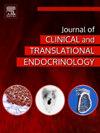False negative rate and concordance of ThyGeNEXT®+ThyraMIR® testing with post-thyroidectomy histopathology
IF 3.3
Q1 ENDOCRINOLOGY & METABOLISM
Journal of Clinical and Translational Endocrinology
Pub Date : 2025-04-24
DOI:10.1016/j.jcte.2025.100396
引用次数: 0
Abstract
Objective
This study aimed to assess the false negative rate (FNR) and concordance of pre-operative ThyGeNEXT®+ThyraMIR® testing in Bethesda category III-V thyroid nodules by comparing results with post-surgical histopathology in thyroid cancer.
Methods
A retrospective review was conducted on 19 patients with Bethesda III-V thyroid nodules who underwent ThyGeNEXT®+ThyraMIR® testing followed by total thyroidectomy with histopathology confirming thyroid cancer. Fine needle aspiration (FNA) cytology, molecular test results, post-surgical histopathology and comprehensive genomic profiling reports (when available) were examined. Concordance was assessed by comparing pre-operative test results (mutations or malignant miRNA expression) to post-surgical histopathology. Discrepancies were further explored using Tempus xT genomic profiling for additional mutations and evaluation of tumor heterogeneity. The FNR was calculated accordingly.
Results
FNR was 10.5 % and there was a high positive concordance with 89.5 % of cases testing positive for mutations or malignant miRNA classifiers. TERT c.-146C>T, NRAS Q61R, and BRAF V600E were among mutations identified. Comprehensive genomic profiling clarified false negatives, revealing insights into the impact of tumor heterogeneity. The miRNA classifier proved effective in detecting malignancy, in cases with subthreshold and RAS mutations or without common genetic alterations. Reliable results were obtained from diverse specimen types.
Conclusions
The low false-negative rate and positive concordance with histopathology highlights the utility of ThyGeNEXT® + ThyraMIR® in enhancing risk stratification and guiding personalized management of indeterminate thyroid nodules and thyroid cancer.
ThyGeNEXT®+ThyraMIR®检测与甲状腺切除术后组织病理学的假阴性率和一致性
目的通过与甲状腺癌术后组织病理学的比较,评估术前ThyGeNEXT®+ThyraMIR®检测在Bethesda III-V类甲状腺结节中的假阴性率(FNR)和一致性。方法对19例Bethesda III-V型甲状腺结节患者进行回顾性分析,这些患者接受了ThyGeNEXT®+ThyraMIR®检测,并行甲状腺全切除术,组织病理学证实为甲状腺癌。检查细针抽吸(FNA)细胞学、分子检测结果、术后组织病理学和全面的基因组分析报告(如有)。通过比较术前检查结果(突变或恶性miRNA表达)与术后组织病理学来评估一致性。使用Tempus xT基因组分析进一步探讨了其他突变和肿瘤异质性评估的差异。FNR据此计算。结果fnr为10.5%,89.5%的病例检测出突变或恶性miRNA分类阳性。发现的突变包括TERT c.-146C>;T、NRAS Q61R和BRAF V600E。全面的基因组分析澄清了假阴性,揭示了对肿瘤异质性影响的见解。miRNA分类器在检测恶性肿瘤时被证明是有效的,在亚阈值和RAS突变或没有常见遗传改变的情况下。从不同的标本类型中获得可靠的结果。结论ThyGeNEXT®+ ThyraMIR®在不确定甲状腺结节和甲状腺癌的风险分层和指导个性化治疗方面具有较低的假阴性率和与组织病理学的阳性一致性。
本文章由计算机程序翻译,如有差异,请以英文原文为准。
求助全文
约1分钟内获得全文
求助全文
来源期刊

Journal of Clinical and Translational Endocrinology
ENDOCRINOLOGY & METABOLISM-
CiteScore
6.10
自引率
0.00%
发文量
24
审稿时长
16 weeks
 求助内容:
求助内容: 应助结果提醒方式:
应助结果提醒方式:


